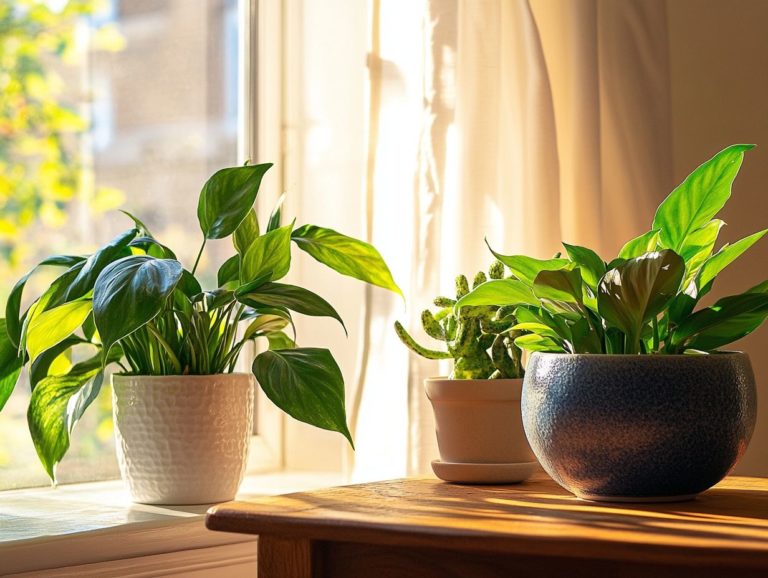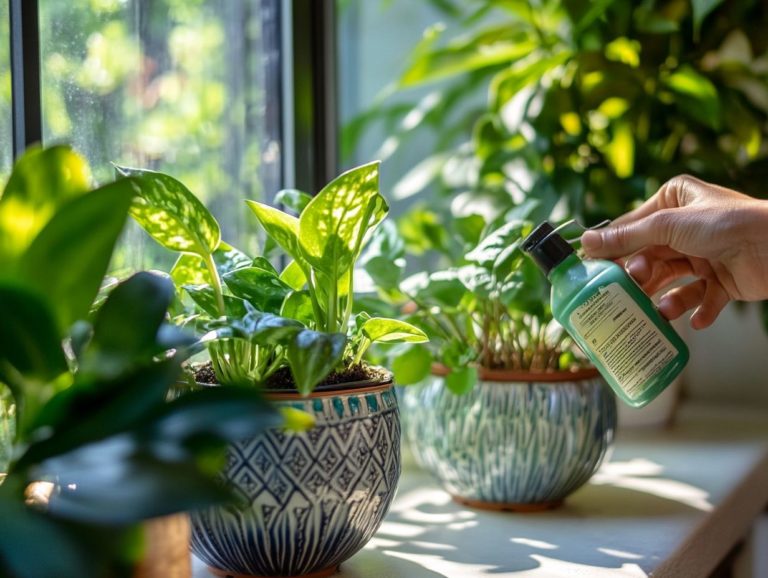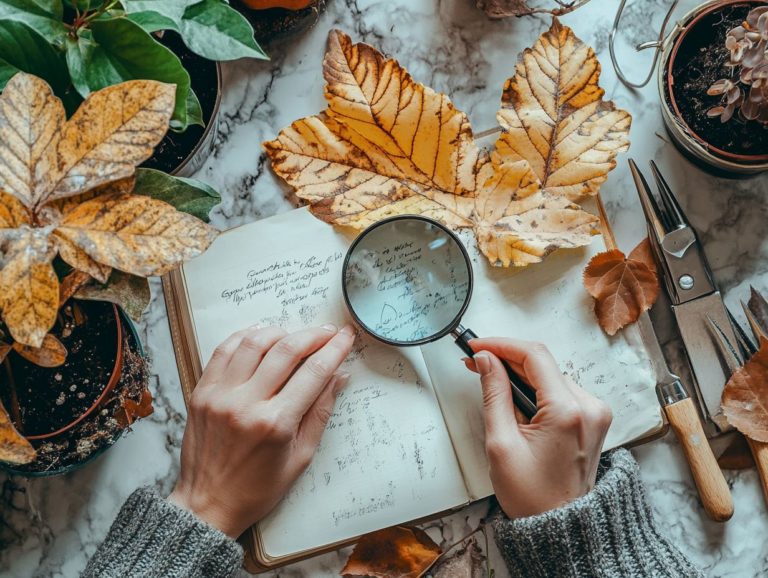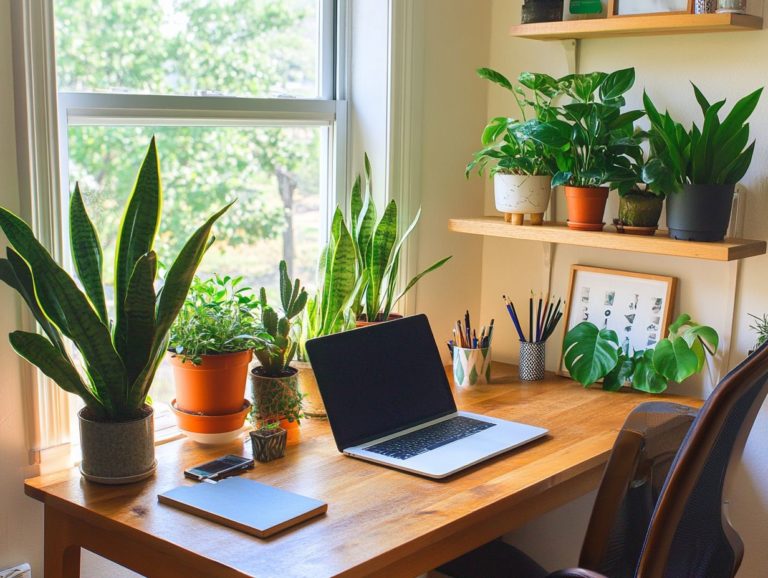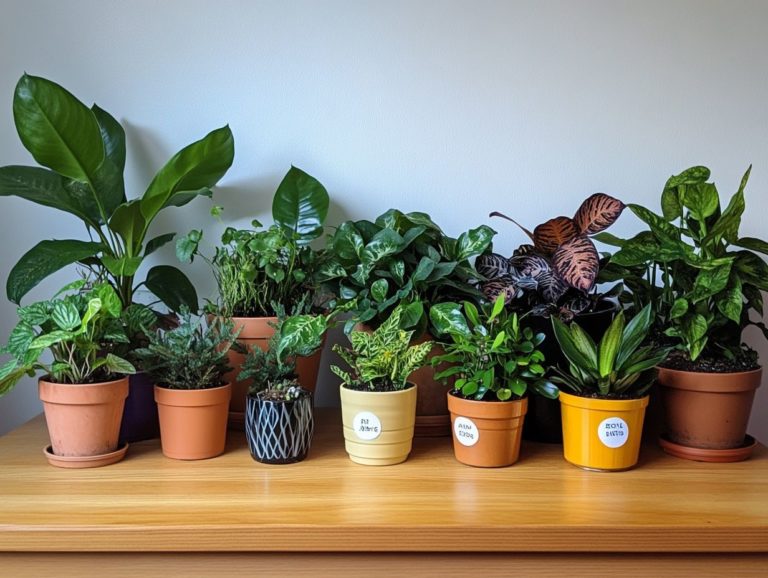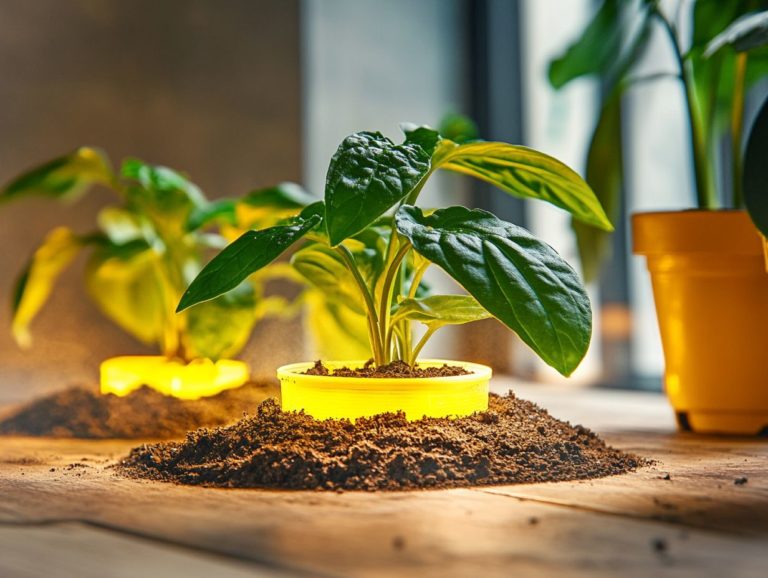What are the Best Practices for Indoor Plant Care?
Indoor plants, also known as houseplants, have gone beyond mere decorations. They now play an important role in enhancing your living spaces.
Not only do they purify the air and uplift your mood, but they also infuse a sense of tranquility into your home. This guide will walk you through the best practices for indoor plant care, from selecting the ideal plants to understanding their specific needs and avoiding common pitfalls.
Imagine the joy of filling your home with vibrant plants! They can transform your indoor space into a lively sanctuary. Whether you re a seasoned plant parent or just starting your indoor gardening journey, this article offers valuable insights and essential tips to help your indoor garden flourish.
Contents
Key Takeaways:
Act now to enjoy the countless benefits of indoor plants!
- Indoor plants have numerous benefits, including improved air quality and mood enhancement.
- Consider factors such as light, water, and temperature requirements when selecting indoor plants.
- Maintaining a consistent care routine, avoiding common mistakes, and troubleshooting plant problems are essential for successful indoor plant care.
Why Indoor Plants Matter
Having indoor plants offers a wealth of benefits that elevate not just the visual charm of your living space but also your overall well-being. Consider inviting plants like pothos, spider plants, philodendron, and tropical varieties into your home. They can significantly enhance air quality by filtering out harmful toxins and releasing oxygen through photosynthesis.
These green companions uplift your mood and reduce stress, making them vital for creating a peaceful atmosphere in your indoor garden. By incorporating plants such as fiddle leaf figs and dwarf citrus trees, you can enrich your indoor environment, promoting both health and happiness in your daily life.
Improving Air Quality & Mood
Indoor plants such as spider plants and pothos do wonders for your air quality and mood, making them excellent additions to your home.
These green companions are not just pretty faces; they actively filter toxins from the air and cultivate a tranquil atmosphere that uplifts your spirits. Research has shown that surrounding yourself with indoor greenery, especially low-maintenance houseplants, can significantly reduce stress levels and enhance focus, fostering a productive environment.
The visual allure of lush foliage brings a refreshing touch to your decor, transforming even the most mundane spaces into vibrant sanctuaries that highlight the beauty of indoor plants. With their remarkable ability to absorb carbon dioxide and release oxygen, these plants contribute to a healthier indoor atmosphere and offer a natural aesthetic that elevates your overall well-being.
Choosing the Right Indoor Plants
Selecting the right indoor plants is essential for their thriving presence in your home. Factors such as the choice of container, drainage holes, and light exposure can profoundly influence their health and growth.
Opting for low-maintenance houseplants, like cacti, succulents, and spider plants, simplifies your gardening journey, especially if you’re just starting out.
Understanding the specific requirements of tropical plants or herbs, such as basil, micro-greens, and philodendron, empowers you to create perfect indoor gardening conditions. This thoughtful approach not only fosters successful growth but also enhances the visual appeal of your living space.
Factors to Consider When Selecting Plants
When selecting indoor plants, it’s exciting to choose the right ones! Consider factors like light exposure, drainage holes, and the type of potting soil used. High-quality options like Espoma potting mix greatly influence plant growth.
For example, if you have bright, indirect light, a Sansevieria (Snake Plant) or Pothos can thrive beautifully in your space. If your environment leans toward low light, you’ll find that ZZ Plants or Peace Lilies make ideal choices for low-maintenance houseplants.
Understanding moisture needs is essential. A succulent like Echeveria will flourish with minimal watering, while ferns prefer their soil to remain consistently damp. Don t overlook drainage; using pots with adequate holes is vital for preventing overwatering especially for sensitive plants like the Spider Plant.
By acknowledging these variables, you can create a vibrant indoor garden that complements your living conditions perfectly.
Essential Elements for Indoor Plant Care

Caring for indoor plants requires a keen understanding of essential elements such as watering requirements, how to trim your plants, and proper fertilizing methods. These practices foster healthy growth and a vibrant appearance, along with effective insect control for maintaining plant health.
Effective houseplant care isn t just about knowing each plant’s unique needs, including moisture retention and nutrient balance. It also involves regular maintenance to avoid common pitfalls like overwatering and pest infestations. Keep an eye out for houseplant diseases, too!
Using high-quality products like Espoma potting mix and J R Peters fertilizer, along with appropriate plant food, can elevate your plants’ health and longevity.
Light, Water, and Temperature Requirements
Understanding the light, water, and temperature requirements of your indoor plants is essential for cultivating a flourishing garden and ensuring their healthy growth.
Recognizing the unique needs of these plants, especially those that thrive in tropical environments or those requiring minimal care, will help you create an optimal setting. To further enhance your purchasing decisions, consider what to look for when buying indoor plants. This encourages vibrant foliage and flowering by ensuring proper light exposure and watering needs.
Many tropical varieties love bright, indirect light and consistently moist conditions. In contrast, lower-maintenance options like succulents flourish in well-draining soil and need watering less frequently. To avoid misconceptions, it’s helpful to understand common myths about indoor plants.
Maintaining a stable temperature generally between 65 F and 75 F will help prevent stress and disease, leading to healthier indoor greenery. Adjusting light exposure and watering routines according to seasonal changes truly makes a difference in nurturing robust, thriving plants.
Common Mistakes in Indoor Plant Care
Common mistakes in indoor plant care, like overwatering and overlooking pest control, lead to significant challenges. These can include houseplant diseases and stunted growth, often due to improper plant maintenance.
<pIt's essential to grasp the specific watering needs of each plant type, especially succulents and cacti, as proper moisture retention is key to their flourishing.
Being proactive in identifying plant pests and employing effective insect control methods, such as neem oil or insecticidal soap, helps prevent infestations. This ensures the vibrant health of your plants, allowing for a thriving indoor garden.
Avoiding Overwatering and Underwatering
Avoiding both overwatering and underwatering is essential for maintaining healthy plant roots and overall vitality. These factors are crucial for plant growth. Each condition can wreak havoc on your plants. Understanding the subtle differences between these extremes gives you the power to create an optimal environment where your plants can truly flourish.
Regarding overwatered plants, you might notice yellowing leaves, wilting, and even root rot. The remedy? Simply adjust your watering schedule and ensure good drainage.
On the flip side, if your plants are underwatered, they’ll likely display dry, crispy leaves and stunted growth. Fortunately, increasing your watering frequency can quickly remedy this situation.
It’s also crucial to consider how moisture is retained in the soil. Using well-draining soil and maintaining appropriate watering requirements is key. Well-draining soil prevents excess water from becoming an issue, while incorporating organic matter enhances moisture retention. This way, you ensure your plants receive just the right balance they need to thrive.
Creating a Plant Care Routine
Creating a regular plant care routine can make a big difference! This routine is essential for the long-term health and allure of your indoor plants. Regular tasks include watering, cleaning the leaves, and monitoring their growth conditions.
By committing to this routine, you ensure your plants thrive and continue to enhance your living space through improved appearance and health.
Tips for Consistent Care and Maintenance

To ensure consistent care and maintenance of your indoor plants, consider incorporating a few simple yet effective tips. Use the right plant food and stick to a regular watering schedule while keeping a lookout for plant pests!
Keeping a close eye on each plant’s growth can help you spot potential issues early, allowing for timely intervention. Regularly checking for pests or signs of disease is crucial. Implementing insect control methods during inspections can save your greenery from significant damage.
Adjusting your care routine with the changing seasons is vital, especially regarding light exposure and watering requirements. Indoor plants often need different levels of light, humidity, and water based on their environment. For instance, knowing what is the best temperature for indoor plants can significantly affect their growth. Staying attuned to those shifts will help them thrive.
Documenting your observations can help you develop a personalized routine that nurtures your plants effectively over time. This way, your indoor garden becomes not just a hobby but a flourishing sanctuary where plant growth is nurtured.
Troubleshooting Common Plant Problems
Troubleshooting common plant problems is a critical skill for indoor gardeners. It needs careful attention to identify issues early and the expertise to implement effective solutions against houseplant diseases and pests.
Mastering this skill can transform your gardening experience and ensure that your plants thrive in their indoor sanctuary.
Identifying and Addressing Plant Issues
Identifying and addressing plant issues promptly can save your houseplants from severe damage, ensuring they remain healthy and vibrant.
Regularly monitoring your plants’ health is essential for maintaining their overall well-being. Common issues like yellowing leaves, stunted growth, and wilting can signal various problems, from overwatering to pest infestations. For example, if you notice leaves turning a pale yellow, it might indicate a nutrient deficiency which means your plant isn’t getting enough food to grow well. Meanwhile, brown leaf tips could suggest too much direct sunlight or insufficient hydration. By inspecting your plants frequently, you can catch these symptoms early.
Here are some straightforward troubleshooting tips to keep in mind:
- Adjust your watering schedule according to seasonal changes.
- Use organic fertilizers to replenish essential nutrients.
- Employ natural pest control methods to keep unwanted visitors at bay.
Investing time to understand and respond to these signs will result in thriving, lush greenery in your home. Start observing your plants carefully today to keep them healthy!
Incorporating Indoor Plants into Home Decor
Incorporating indoor plants into your home decor elevates the aesthetic appeal and cultivates a refreshing atmosphere. When you thoughtfully place plants like Monstera and African violets, they can beautifully complement a range of design styles, from modern to rustic.
By employing clever styling tips, you can create stunning plant displays that highlight the unique beauty of each plant. They also fulfill functional roles, such as enhancing air quality and filling the air with moisture.
Design and Styling Tips
Implementing effective design and styling tips for indoor plants can transform your home decor. You can create a comfortable home.
Thoughtfully consider the placement of your plants and select the right containers. Arrange them in visually appealing groupings to significantly enhance your interiors.
For instance, positioning a tall, leafy plant near a window draws the eye upward and brightens your room. Meanwhile, smaller plants clustered on shelves or coffee tables add depth and texture.
Choose containers that complement your decor. Earthy terracotta pots work well for a rustic vibe, while sleek ceramic options suit modern styles.
Layer different heights and varieties for a stunning display. Mix various colors and leaf shapes to keep the arrangement dynamic and inviting.
Frequently Asked Questions
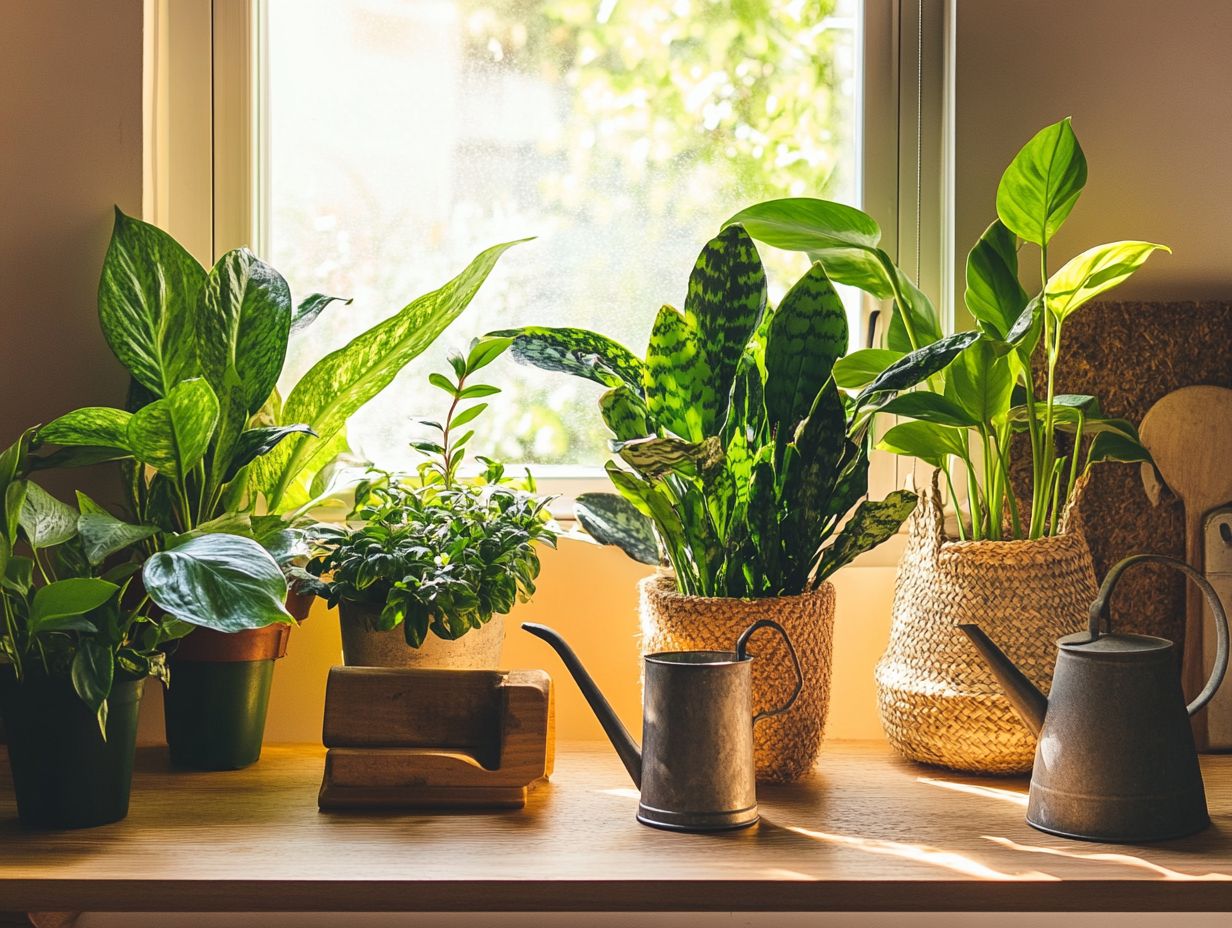
What are the Best Practices for Indoor Plant Care?
There are several best practices for indoor plant care. This includes proper watering, adequate lighting, and proper fertilization.
How often should I water my indoor plants?
The frequency of watering depends on the type of plant. A general rule is to water when the top inch of soil is dry.
Overwatering can be just as harmful as underwatering.
What is the best way to provide adequate lighting for indoor plants?
Indoor plants typically need bright, indirect light. Place them near a window or use artificial grow lights.
Do indoor plants need to be fertilized?
Yes, indoor plants should be fertilized regularly. Use a balanced, water-soluble fertilizer according to the instructions on the package.
How do I prevent pests from infesting my indoor plants?
Check your plants often! Catch pests early to keep your greens thriving.
Keep your plants clean and free from debris to prevent infestations.
Is repotting necessary for indoor plants?
Repotting is recommended when the plant becomes root bound. Use a pot that is slightly larger and make sure to use fresh potting soil.
Start adding indoor plants today and transform your space into a green oasis!

